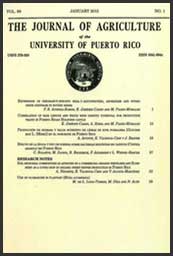Resumen
Se determinaron los efectos de la adición de enzimas exógenas sobre la ingestión y la digestibilidad de la materia seca (MS) y nutrientes y varios parámetros sanguíneos en corderos alimentados con una dieta basal compuesta por 34% de maíz molido, 40% heno de hierba tropical y 26% de harina de soya proporcionando 21% de almidón. Doce corderos mestizos (22 kg) fueron asignados a uno de cuatro tratamientos: ningún aditivo (1); dietas con adición de la α-amilasa (2); adición de la proteasa (3); o la combinación de ambas enzimas (4). Las dietas (en MS) se ofrecieron diariamente al 4% del peso vivo animal en cuatro periodos experimentales de 28 días, que consistieron en 21 días de adaptación a la dieta seguida por siete días de recolección fecal completa. Se analizaron muestras de estos materiales para contenido de MS, almidón, proteína bruta (PB), y fibra detergente neutro (FDN) para determinar el consumo y la digestibilidad. Al final de cada periodo experimental se obtuvieron muestras de sangre de cada cordero para determinar las concentraciones de glucosa, beta-hidroxibutirato (BHB), ácidos grasos no esterificados (AGNE) e insulina. Los datos se analizaron de acuerdo con un diseño experimental cuadrado latino 4 x 4. Se realizaron contrastes de los tratamientos, utilizando la media de los cuadrados mínimos esperados ajustados para comparaciones múltiples (Tukey-Kramer), de las siguientes combinaciones dietas con adición de enzimas versus sin enzimas, aquellas con la amilasa versus sin amilasa y dietas con proteasa versus sin la misma. El consumo de MS fue similar en todos los tratamientos (1,106; 1,088; 1,105 y 1,088 g/d para las dietas 1, 2, 3 y 4 en orden). La adición de la proteasa disminuyó (P<0.05) el consumo de almidón (248 vs. 255 g/d) y aumentó, no significativamente, la digestibilidad de FDN (48.6 vs. 46.8%) en comparación con el tratamiento sin la enzima. La adición de enzimas a la dieta tendió (P<0.10) a disminuir la concentración sanguínea de BHB por debajo del nivel testigo (4.26 vs. 4.68 mg/dL). La concentración de AGNE en la sangre tendió a aumentar (P<0.10) en corderos alimentados con α-amilasa versus sin α-amilasa (0.17 vs. 0.14 mEq/L). El nivel de insulina tendió (P<0.10) a aumentar en corderos alimentados con la proteasa en comparación con los alimentados sin la enzima (80.3 vs. 71.8 pmol/L). Los niveles de glucosa fueron similares para todos los tratamientos. Ambas enzimas exógenas influyeron sobre los componentes sanguíneos, pero se observó un mayor efecto con la proteasa.

